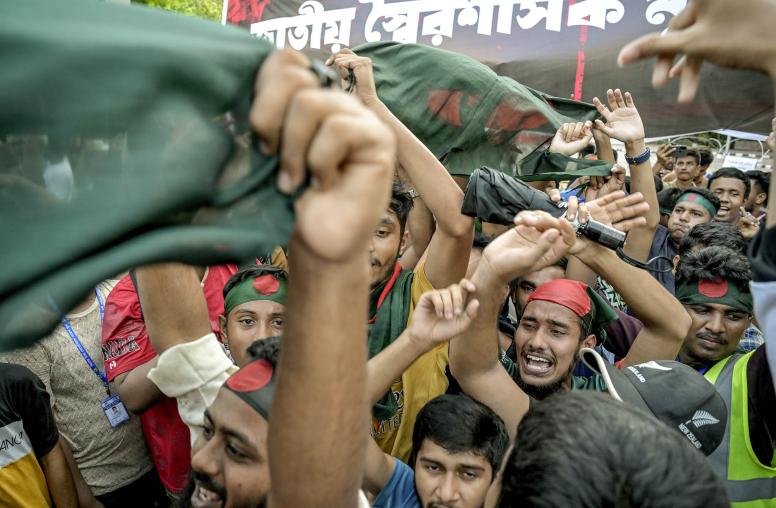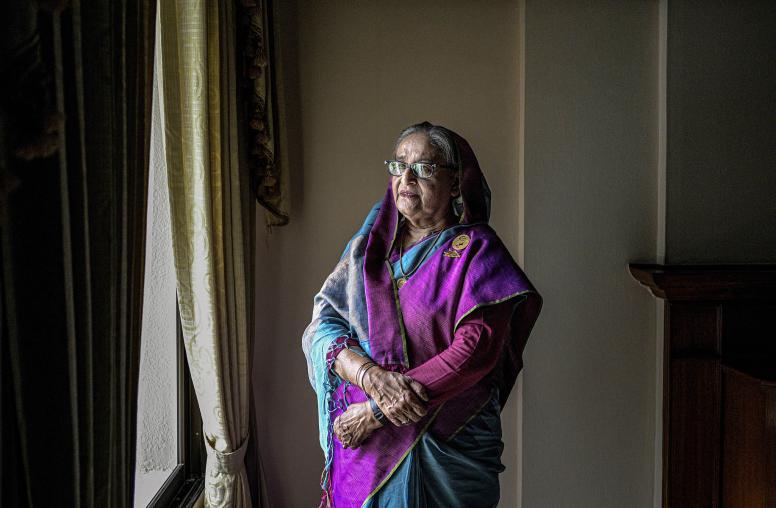It’s Time for South Asia to Talk Climate
The potential benefits of cooperation on climate are essentially limitless for the region.
That India and Pakistan are engaged in backchannel track 2 diplomacy is the worst kept secret in South Asia. It does not take a vivid imagination to guess what dominates the agenda at these talks: Kashmir, terrorism, trade, perhaps crisis behavior under the shadow of nuclear weapons. Welcome as such conversations are, they are almost assuredly lacking focus on the biggest crisis facing the region’s inhabitants: climate change.

South Asia’s Climate Change Vulnerability
This year has served as a living, heaving reminder of the World Bank’s dire warnings about climate change in the region. Pakistan’s flooding has led to a catastrophic humanitarian crisis: thousands dead, tens of millions homeless, millions of acres of food lost, and tens of billions of dollars’ worth of damages. Few witnesses to the country’s apocalyptic floods in 2010 could have foreseen that barely a decade later, their experience would be surpassed.
Meanwhile, India has faced both drought (West Bengal, Uttar Pradesh) and flooding (Madhya Pradesh, Maharashtra, Telegana and Andhra Pradesh), even sometimes in the same state (Bihar). It has lost a quarter of its wheat and a third of its rice production. Bangladesh too has experienced drought and floods concomitantly.
Climate change is driving these disasters. Historically in South Asia, the four months of the monsoon supply 80% of annual rainfall. Climate change has accelerated that water cycle, leading to extreme levels of rain in short periods, and droughts otherwise. Certain Pakistani provinces and cities, for example, have been hit with 400 to 500% more rainfall this year than the annual average, sometimes in a matter of weeks.
By its nature, the climate crisis is transnational. A glacier melting in one locale changes agriculture in many others. Rivers that gather apace in one country flood another: the Indus, Ganges and Brahmaputra rivers, the three big rivers in the region, each span several countries. Air sheds, in which pollution circulates, do not respect political boundaries, evinced by cities across the subcontinent — like Kabul, Lahore, New Delhi and Dhaka — suffering severe air catastrophes.
Cooperation is Key
Unfortunately, even among the most cooperative of countries, multilateral efforts to combat climate change are difficult because national leaders worry about sacrificing sovereignty, insincere international partners and/or domestic backlashes. These problems are exacerbated in South Asia, arguably the least integrated and most geopolitically dysfunctional region in the world.
But climate change is not a zero-sum game. It is the rare international political question on which India and Pakistan, not to mention Afghanistan, Bangladesh, Nepal and Sri Lanka, are — or should be — on the same side.
Dividing the world into rough blocs, one which has caused climate change (the rich) and the other that is suffering the worst of it (the poor), it is clear where South Asia belongs. While the G20 countries have been jointly responsible for 80% of global emissions, Pakistan, with a population of almost 250 million, and the site of “a level of climate carnage beyond imagination,” in the words of the U.N. secretary general, has been collectively responsible for less than 1%.
There is a lot to be gained by India, Pakistan and Bangladesh carving out a regional approach to climate change. Indeed, for many in South Asia, from government officials to development experts to journalists, there is a strong moral and economic argument for Western nations paying climate reparations to their countries. But for such a position to assume real geopolitical significance, South Asian leaders must band together and make the case in a unified and coherent way. It would be difficult for world powers to ignore two billion people speaking as one.
Beyond its prospects as a bloc in the burgeoning field of climate diplomacy, the potential benefits of cooperation on climate are essentially limitless for the region. The low-hanging fruit is sharing information and data.
First, upstream countries can share real-time data on river flow to downstream neighbors, limiting the damage from floods. Second, there can be collaboration across the eight Himalayan countries to monitor and report snowfall and ice patterns on glaciers — data which has global, not just regional, implications. (At present, there are only two posts for monitoring glaciers across the entire Himalayan range). Third, more sophisticated metropolitan departments, such as India’s, can share advanced storm warnings with their neighbors; in general, there can be considerably greater coordination on disaster management. Fourth, farming communities can share best practices, such as information on crop varieties or reusing crop waste as biofuel.
Such measures have the benefit of not seeking to change behavior, which can be challenging, but telling others what one already knows. They also enjoy ample precedent.
Thousands of lives have been saved by China supplying both India and Bangladesh with data on the Brahmaputra river, as well as villages in India, Bhutan and Nepal using WhatsApp to share real-time information on river flows. Several South Asian countries have learned of the inadvisability of kilns or the advisability of drip agriculture from one another. Indian and Bangladeshi scientists helped restore the Hilsa fish from overfishing. Until half a decade ago, Pakistani and Indian activists managed to meet regularly. Heat mitigation plans emanating from one country have been adopted by cities in others.
Let Local and Provincial Leaders and Communities Lead
But rather than be ad-hoc, such information and data-sharing needs a stable, institutionalized mechanism. Importantly, New Delhi, Islamabad and Dhaka need not drive such conversations. If anything, collaboration is more likely to be sustained and useful if the capitals, major politicians and big ministries get out of the way.
Instead, states (India’s and Pakistan’s Punjabs, say) and cities can lead the way. Municipal authorities, especially, are on the frontlines of the battles over water, electricity and pollution, and must be at the forefront of discussions on climate. After all, if Arctic cities spread across eight countries can institutionalize meetings at the mayoral level, why not Himalayan cities such as Kabul, Peshawar, Kathmandu and Srinagar?
Then there are harder sells and steps requiring more political capital. For instance, there is friction involved in almost each of the dozens of treaties governing river waters in South Asia. Drafting the next generation of water treaties, which don’t just divide rivers but rather share their management and benefits, is a major challenge.
At a similar scale of ambition, governments and farmers have to consider wholesale and fundamental changes in agriculture, from what the public eats to what farmers grow to what governments tax and subsidize. Similarly, the region’s very conceptualization of natural resources needs updating: for example, can river water be used for transit, as it was before the advent of roads, to benefit poverty-stricken communities living on river banks?
Climate is also a part of thorny discussions on trade. For instance, were trade discussions to advance, it is probable that India’s considerably more advanced market in electric vehicles, if opened to Pakistan, would benefit air quality across the Indo-Gangetic plain.
A Region-wide Energy Grid Builds Interdependence
Finally, there is the extreme end of the spectrum, the “big idea” that is least likely but could transform South Asian and indeed global politics: a region-wide renewable energy grid. The complementarity of demand and supply makes the region highly suitable for such plans. Between hydropower, solar and wind, South Asia has enormous potential for renewable energy. Connecting disparate states across thousands of miles to a grid in which everyone participates and contributes could be an economic, ecological and energy miracle.
The idea of sworn enemies putting their economies in the hands of the other seems fanciful and foolish, nigh on suicidal. Haven’t we received lesson enough from the Russia-Ukraine war that relying on geopolitical rivals for energy is perilous?
But a region-wide grid would, by virtue of being spread through the many countries, decrease any one actor’s leverage. Rather than Russia cutting off gas to Europe, the better analogy from that continent might be the European Coal and Steel Cooperation, the antecedent to the European Union, which married French and German steel and coal production based on the idea that they could better avoid war if they put their economic fate into the other’s hands. It was essentially a form of mutually assured destruction — a concept Indians and Pakistanis are, of course, already well-versed in.
To be sure, despite an Indian prime minister recently outlining the precursor to such an idea, no reasonable observer would bet that South Asia is ready for such deep engagement, stricken as it is by decades of wars, threats, mistrust and ugly nationalism. Cooperation on water and air within countries, among provinces and states, has proved hard enough, let alone across rancorous international borders. Separately, the political economy of many South Asian societies has bequeathed vast amounts of wealth and political capital in the hands of real-estate magnates, who often stand in the way of sensible policy adjustment to climate change.
Regardless of the specifics, it is well past time for India, Pakistan and Bangladesh – along with Afghanistan, Nepal, Sri Lanka, Bhutan and the Maldives – to put aside their squabbles and begin region-wide conversations on climate adaptation and mitigation. Such conversations contain the potential for permanently transforming the tone, tenor and substance of international relations in South Asia, as well as substantially raising the neighborhood’s joint capabilities to limit the damage wreaked by climate crises. Pakistan’s deadly floods serve as just the latest reminder that few tasks in global affairs are more urgent.
Ahsan Butt is an associate professor at the Schar School of Policy and Government at George Mason University and a nonresident senior fellow at the Atlantic Council.



